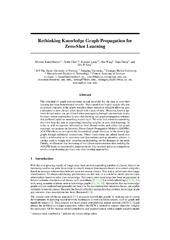| dc.contributor.advisor | Robert, Jenssen | |
| dc.contributor.author | Kampffmeyer, Michael Christian | |
| dc.date.accessioned | 2018-12-03T06:44:08Z | |
| dc.date.available | 2018-12-03T06:44:08Z | |
| dc.date.issued | 2018-10-19 | |
| dc.description.abstract | Due to the large improvements that deep learning based models have brought to a variety of tasks, they have in recent years received large amounts of attention.
However, these improvements are to a large extent achieved in supervised settings, where labels are available, and initially focused on traditional computer vision tasks such as visual object recognition. Specific application domains that consider images of large size and multi-modal images, as well as applications where labeled training data is challenging to obtain, has instead received less attention.
This thesis aims to fill these gaps from two overall perspectives. First, we advance segmentation approaches specifically targeted towards the applications of remote sensing and medical imaging. Second, inspired by the lack of labeled data in many high-impact domains, such as medical imaging, we advance four unsupervised deep learning tasks: domain adaptation, clustering, representation learning, and zero-shot learning.
The works on segmentation address the challenges of class-imbalance, missing data-modalities and the modeling of uncertainty in remote sensing. Founded on the idea of pixel-connectivity, we further propose a novel approach to saliency segmentation, a common pre-processing task. We illustrate that phrasing the problem as a connectivity prediction problem, allows us to achieve good performance while keeping the model simple. Finally, connecting our work on segmentation and unsupervised deep learning, we propose an approach to unsupervised domain adaptation in a segmentation setting in the medical domain.
Besides unsupervised domain adaptation, we further propose a novel approach to clustering based on integrating ideas from kernel methods and information theoretic learning achieving promising results. Based on our intuition that meaningful representations should incorporate similarities between data points, we further propose a kernelized autoencoder. Finally, we address the task of zero-shot learning based on improving knowledge propagation in graph convolutional neural networks, achieving state-of-the-art performance on the 21K class ImageNet dataset. | en_US |
| dc.description.doctoraltype | ph.d. | en_US |
| dc.description.popularabstract | Due to the large improvements that deep learning based models have brought to a variety of tasks, they have in recent years received large amounts of attention and are nowadays often unknowingly used by many people on a daily basis. In this thesis, we focus on two aspects within the field of deep learning: segmentation and unsupervised learning.
Segmentation aims to deliver fine-grained image understanding, by assigning pixels in an image to a given class. Segmentation based on images taken from airplanes and satellites have for example been used for environmental monitoring, forestry, and disaster monitoring. This thesis advances deep learning segmentation approaches specifically targeted towards applications of remote sensing and medical imaging.
Further, inspired by the lack of labeled data in many high-impact domains, such as medical imaging, we propose methodology targeted towards four unsupervised tasks: domain adaptation, clustering, representation learning and zero-shot learning. | en_US |
| dc.description.sponsorship | The work was funded by the Norwegian Research Council FRIPRO grant no. 239844 on developing the Next Generation Learning Machines. | en_US |
| dc.identifier.isbn | 978-82-8236-316-7 (trykt) og 978-82-8236-317-4 (pdf) | |
| dc.identifier.uri | https://hdl.handle.net/10037/14264 | |
| dc.language.iso | eng | en_US |
| dc.publisher | UiT Norges arktiske universitet | en_US |
| dc.publisher | UiT The Arctic University of Norway | en_US |
| dc.relation.haspart | <p>Paper I: Kampffmeyer, M., Salberg, A-B. & Jenssen, R. (2016). Semantic segmentation of small objects and modeling of uncertainty in urban remote sensing images using deep convolutional neural networks. <i>IEEE Conference on Computer Vision and Pattern Recognition (CVPR) Workshops</i>, 1-9. Full text not available in Munin due to publisher restrictions. Published version available at <a href=https://doi.org/10.1109/CVPRW.2016.90>https://doi.org/10.1109/CVPRW.2016.90.</a><p>
<p>Paper II: Kampffmeyer, M., Salberg, A-B. & Jenssen, R. (2018)). Urban Land Cover Classification with Missing Data Modalities Using Deep Convolutional Neural Networks. <i>IEEE Journal of Selected Topics in Applied Earth Observations and Remote Sensing, 11</i>,(6), 1758-1768. Full text not available in Munin due to publisher restrictions. Published version available at <a href=https://doi.org/10.1109/IGARSS.2017.8128164> https://doi.org/10.1109/IGARSS.2017.8128164. </a><p>
<p>Paper III: Dong, N., Kampffmeyer, M., Liang, X., Wang, Z., Dai, W. & Xing, E.P. (2018). Unsupervised Domain Adaptation for Automatic Estimation of Cardiothoracic Ratio. (Manuscript). Published version in Frangi, A.F. et al. (Eds.) Medical Image Computing and Computer Assisted Invervention – MICCAI 2018. MICCAI 2018. Lecture Notes in Computer Science, 11071. Springer, Cham, available at <a href=https://doi.org/10.1007/978-3-030-00934-2_61>https://doi.org/10.1007/978-3-030-00934-2_61. </a><p>
<p>Paper IV: Kampffmeyer, M., Dong, N., Liang, X., Zhang, Y. & Xing, E.P. ConnNet: A Long-Range Relation-Aware PixelConnectivity Network for Salient Segmentation. (Manuscript). Also available at <a href= https://arxiv.org/abs/1804.07836>https://arxiv.org/abs/1804.07836. </a>. <p>
<p>Paper V: Kampffmeyer, M., Løkse, S., Bianchi, F.M., Jenssen, R. & Livi, L. The Deep Kernelized Autoencoder. (Manuscript). Published version in <i>Applied Soft Computing, 71</i>, 816-825, available at <a href=https://doi.org/10.1016/j.asoc.2018.07.029>https://doi.org/10.1016/j.asoc.2018.07.029. </a><p>
<p>Paper VI: Kampffmeyer, M., Løkse, S., Bianchi, F.M., Livi, L., Salberg, A-B. & Jenssen, R. Deep Divergence-Based Approach to Clustering. (Manuscript).<p>
<p>Paper VII: Kampffmeyer, M., Chen, Y., Liang, X., Wang, H., Zhang, Y. & Xing, E.P. Rethinking Knowledge Graph Propagation for Zero-Shot Learning. (Manuscript). Also available at <a href=https://arxiv.org/abs/1805.11724>https://arxiv.org/abs/1805.11724. </a><p> | en_US |
| dc.rights.accessRights | openAccess | en_US |
| dc.rights.holder | Copyright 2018 The Author(s) | |
| dc.rights.uri | https://creativecommons.org/licenses/by-nc-sa/3.0 | en_US |
| dc.rights | Attribution-NonCommercial-ShareAlike 3.0 Unported (CC BY-NC-SA 3.0) | en_US |
| dc.subject | Machine Learning | en_US |
| dc.subject | VDP::Mathematics and natural science: 400::Physics: 430 | en_US |
| dc.subject | VDP::Matematikk og Naturvitenskap: 400::Fysikk: 430 | en_US |
| dc.title | Advancing Segmentation and Unsupervised Learning Within the Field of Deep Learning | en_US |
| dc.type | Doctoral thesis | en_US |
| dc.type | Doktorgradsavhandling | en_US |


 English
English norsk
norsk





